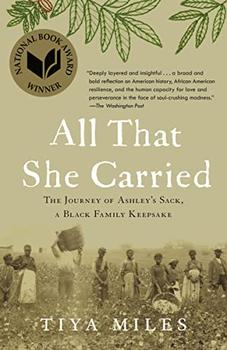Summary | Excerpt | Reviews | Beyond the Book | Readalikes | Genres & Themes | Author Bio

The Journey of Ashley's Sack, a Black Family Keepsake
by Tiya Miles
Ruth's fabric testament to Black love and women's perseverance did not—perhaps could not—exist in any historical archive. Though necessary to the work of uncovering the past, archives are nevertheless limited and misleading storehouses of information. While at times imposing and formal enough as to seem all-encompassing in their brick, glass, and steel structures, archives only include records that survived accident, were viewed as important in their time or in some subsequent period, and were deemed worthy of preservation. These records were originally created by fallible people rather like you and me, who could err in their jottings, hold vexed feelings they sometimes transmitted onto the page, or consciously or unconsciously misconstrue events they witnessed. Even in their most organized form, archived records are mere scraps of accounts of previous happenings, "rags of realities" that we painstakingly stitch together in order to picture past societies.
Even when compared with the motley rags that make up the archives of history, the nineteenth-century seed sack that we are exploring together here appears particularly threadbare. Ruth's embroidery is the only definitive primary source detailing the fate of Rose and Ashley. In addition, read in a certain mood, Ruth's verse on the bag can feel more like poetry than reportage. Slight on facts and specifics, the embroidered text states only three names (Rose, Ruth, and Ashley), one place (South Carolina), and one date (1921). None of the sources that scholars typically use to reconstruct histories of slavery directly address this object. No plantation supply log exists that tells of the sack's manufacture or acquisition. No mistress's handwritten letter describes an interaction with Rose. No formal bill of sale lists a buyer of Ashley. No published slave narrative describes this family and their travails. The bag dates back to the 1840s or 1850s, but the writing was added in the 1920s. And perhaps most glaringly—and, for the historian, most alarmingly—we have only one person's word that events took place as described and that the bag was packed with the listed items.
Ruth Middleton, that one person, probably rendered the details as she recalled them. While we can presume that she told the truth as she knew it, Ruth's version of events was formed, like any other, through the lenses of memory and narrative desire—what she consciously or unconsciously wanted this family story to mean. There is no reason to think that Ruth wrote this story as fiction, given the form she chose (amateur embroidery on a personal object with no commercial value at the time) as well as the first-person voice she used. The intimate, possessive, and immediate tone of the line "Ashley is my grandmother" suggests that Ruth knew this relative and remembered her. The tale she stitched for private use was by no indications imagined, and by all reckoning, it was true to Ruth. Still, as a vehicle of historical recovery, memory is at least as fallible as paper records. It is possible, even likely, that Ruth mistook, mis-recalled, or rearranged aspects of her emotional family account. We all do this when drawing out and thinking through memory, a malleable store of information "retrieved even as it is refashioned."
Nevertheless, with steady hands we can thread the eye of this needle and ask what Ruth's record can tell us about Black women, Black families, women crafters, and Black material, as well as social, worlds. By doing so, we refuse to give up on those many people of the past who did not—could not—leave behind troves of documents. To abandon these individuals, the "archivally unknown" who fell through the cracks of class, race, and position, would consign them to a "second death" by permitting their erasure from history. It would also mean turning our faces away from fuller, if unwelcome, truths about our country and ourselves. Ruth's account, subjective and incomplete as it may be, stands as a baseline rebuttal to the reams of slaveholder documents that categorized people as objects. Her list of a dress, a braid, pecans, and whispered love accounts for the things that sustained life, rather than rendering lives as things. If Ruth's text did nothing else but replace the "slave list" of our cultural script with Rose's shimmering inventory, it would be enough. And yet Ruth's cloth chronicle does much more. By recovering, for history, Rose, her life conditions, and her act of love, Ruth sets the record straight.
Excerpted from All That She Carried by Tiya Miles. Copyright © 2021 by Tiya Miles. All rights reserved. No part of this excerpt may be reproduced or reprinted without permission in writing from the publisher.
Your guide toexceptional books
BookBrowse seeks out and recommends the best in contemporary fiction and nonfiction—books that not only engage and entertain but also deepen our understanding of ourselves and the world around us.